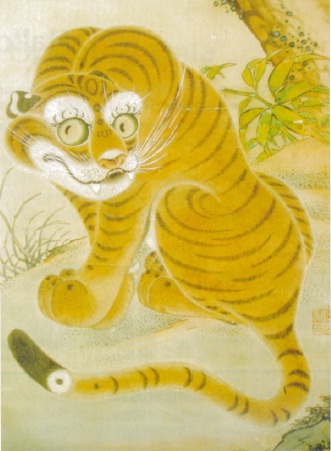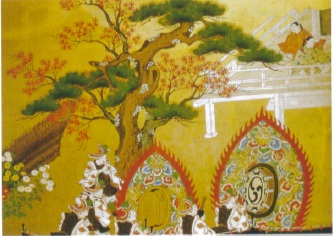Tamsin Bradshaw finds a wealth of welcoming antique stores on her doorstep
Kotto Dori may no longer be the place to go for antiques, but Tokyo still has its fair share of antique stores, and many of them are warm, welcoming and staffed by passionate experts. Here is the pick of the bunch; they stock anything from tansu (chests) and imari porcelain from Arita in Hizen province to paintings and silk screens.
Kurofune
Kurofune owner John Adair Junior has been in the antique business one way or another for a long time. Until he opened Kurofune in 1978, Adair was a private dealer in Tokyo. After a few extremely successful exhibitions, he decided to open up shop.
Thirty years on, Kurofune is going strong, with Japanese furniture and baskets the house specialty. As for the quality of the pieces on offer, Adair’s standards are very high. He’s also very serious about maintaining each piece in as close to its original feel and form as possible. Restoration work is kept to a minimum and done in-house when necessary. If more specialist work is required, the shop can call upon any number of artisans. This way clients can pick up their tansu in as little as one to two days.
Kurofune also carries screens, prints, textiles, and a smattering of porcelain. Like most antique dealers, Adair is concerned about the shrinking selection available to dealers on the hunt for that perfect piece. The competition is fierce. The “overall availability is dropping,” he says. “The days of (supplying) are over for almost everyone.” That’s not to say Adair doesn’t come across buried treasure every now and then. The latest antiques Kurofune has managed to snatch up are a set of the 12 animals of the zodiac from a shrine in Iwate. This set of carved animals was found in storage, packed up when a portion of the shrine was rebuilt.
Such a rare find is bound to be expensive. But Adair is always willing to impart honest advice and to provide his customers with a frank history of the antiques they are thinking of investing in.
What about his personal antique investments? Adair has his own, select obsession: Yokohama-e prints, which were created around the time of Commodore Perry’s arrival in 1853 on the kurofune, the shop’s namesake. Kurofune is the Japanese word for the black ships that carried the Commodore and the United States navy into Edo (Tokyo) Bay. These prints, which depict foreigners from the perspective of Japanese artists, are extremely rare. Their genre was a brief one: it spanned only 15 years in the nineteenth century. Adair, meanwhile, has been collecting them for 20 years. It seems that kurofune—the ships and the shop—are his passion. He refers to his store as “an albatross,” but it’s clear from his dedication and enthusiasm that it’s a loveable one.
7-7-4 Roppongi
Minato-ku
Tel. 03-3479-1552
www.kurofuneantiques.com
Open 10am-6pm (closed Sundays)
The Tolman Collection
Norman H. Tolman, owner of the Tolman Collection in Tokyo, Shanghai, New York and Singapore, first came to Japan 52 years ago. With the United States Air Force at the time, and on a Fulbright scholarship, Tolman started collecting. What began as a hobby soon turned into a lifetime’s work.
These days, Tolman and his wife specialize in prints. Their selection of both old and new prints cannot be surpassed. As Tolman says, they are Japan’s “headquarters of prints,” stocking anything “from the old Kyoto that makes you love Japan, to the avant garde.”
With dozens of contemporary artists whose styles are so varied, the Tolman Collection is not to be missed. The charmingly traditional Japanese exterior houses works by the famous Toko Shinoda, and you will even find the odd piece by a “foreign” artist (including Clifton Karhu). The gallery is very focused on its artists—many of whom created the works in stock specifically for Tolman’s collection—as people rather than concentrating solely on their products. The bilingual staff can tell you all about the artist behind the work. Each of these beautiful prints and paintings comes in many mediums: woodblock, lithograph, silkscreen and etching, to name just a few.
The Tolman Collection may be best known for its selection of contemporary artists’ work, but the gallery also sells a number of antique Kabuki actor prints. All antique prints come framed and are in mint condition.
Tolman’s advice to the novice looking to start a collection? “Only buy what you like,” he says, and don’t think about investments. He also extols the virtues of the quick decision: “Wait too long and it’s gone.”
2-2-18 Shiba Daimon
Minato-ku
Tel. 03-3434-1300
www.tolmantokyo.com
Open llam-7pm (closed Tuesdays)
GSG Associates
George Godoy and his wife Sandra are experts on antique Japanese screens. Japanese screens tend to come in paper or silk, but, over the years, paper screens have proved to be the more resilient and so are more readily available. But the form remains the same; each screen will consist of two or six panels. The viewer can take in each panel on its own, or look at the screen as a whole.
Either way, the screen is best viewed in low light, which brings out the (real) gold detail beautifully, and from floor level. If you are not going to sit on the floor, George Godoy advises raising the screen on a stand or shelf so as to bring it to eye level. Many screens have a tale to tell: whether it is through the portrayal of a samurai lord and his family, or through a detailed map of 18th century Kyoto. The Godoys always sell screens in sets of two. “It’s like buying shoes…the value is in having the pair,” George Godoy says.
The Godoy’s other love is obi zuan. Obi refers to intricately hand-woven kimono belts, and obi zuan describes the original design paintings on which obi are based. The obi artist will conceptualize a design and paint it. The result? A complete, full-color painting made up of one dominant pattern and potentially several other sub-patterns. The subject matter tends to be flowers, fans, wheels, birds, geometric shapes or scenery.
The creation of obi zuan is an ages-old tradition that is slowly dying, in particular among the smaller, lesser-known artists, who are gradually shutting up shop and burning their designs to prevent them from being stolen. These paintings are rare and beautiful treasures that the Godoys stock exclusively.
5-30-10 Shimo-Meguro
Meguro-ku
Tel. 03-3711-6268
www.gsgassociates.com
Antiques Nishikawa
Just off Azabu-juban crossing hides this little gem of a store. Elegant silk screens hang on the walls and gold-flecked obi line the shelves, but it is the delicately painted imari porcelain cups, plates and bowls that dominate the interior.
The imari pieces come in all shapes, sizes and prices, with tiny cups at a mere ¥32 and intricately decorated porcelain creations for a small fortune. If you don’t find exactly what you’re looking for, don’t give up. The bilingual shop assistants are very friendly, helpful, and always happy to supply customer demands.
2-10-14 Azabu-juban
Tel. 03-3456-1023
Open 11 am-7pm
www.nishikawa.to
Okura Oriental Art
These wares are a mixture of the antique and the quirky. You are just as likely to find imari porcelain and 100 year old tansu as you are hina dolls for Girls’ Day. The price range is equally varied, ranging from ¥20,000 to several hundred thousand yen.
Owner Mizue Sasa’s approach is an innovative one: wooden panels from a Japanese home double up as screens, and a fifty year-old food chest makes the perfect display cabinet. For Sasa, buying antiques is about interior decoration above all else. And it shows, too. Each piece looks like it would fit right in at home, and the store’s warm and cozy atmosphere only adds to this.
3-3-14 Azabudai
Minato-ku
Tel. 03-3585-5309
www.okura-art.com
Open 10am-6pm (closed Sun and Mon)
Others
Despite the fact that there are ever fewer and fewer antiques on the market, Tokyo still has its fair share of antique stores. Others to try include Antiques Hasebeya (Tel. 03-5775-1308) in Azabu-juban for tansu, porcelain and lacquer ware, and Mita Arts (Tel. 03-3294-4554) for ukiyo-e, erotica and Adair’s beloved Yokohama-e. Silk (Tel. 03-3505-3469), which mainly sells Chinese antiques, also sells some antique Japanese kimonos.
If you visit any of the shops in this article, you will soon notice that each of them has something in common—aside from having been in the business for 30 years, that is. Tokyo’s antiques vendors have maintained a refreshingly welcoming “mom and pop” element about them. This, coupled with their owners’ love for what they do, makes each visit nearly as much of a treasure as the antiques themselves.










